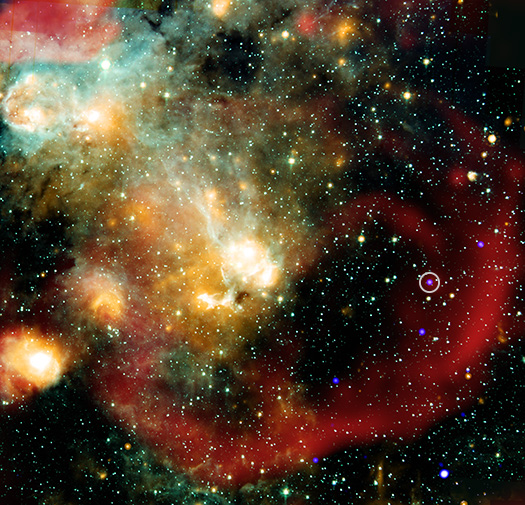For Release: May 28, 2025
NASA/CXC

Credit: X-ray: NASA/CXC/ICRAR, Curtin Univ., Z. Wang et al.; Infrared: NASA/JPL/CalTech/IPAC; Radio: SARAO/MeerKAT; Image processing: NASA/CXC/SAO/N. Wolk
Press Image, Caption, and Videos
Scientists have discovered a star behaving like no other seen before, giving fresh clues about the origin of a new class of mysterious objects.
A team of astronomers combined data from NASA’s Chandra X-ray Observatory and the SKA [Square Kilometer Array] Pathfinder (ASKAP) radio telescope on Wajarri Country in Australia to study the antics of the discovered object, known as ASKAP J1832−0911 (ASKAP J1832 for short), located 15,000 light-years from Earth. Their results were published Wednesday in the journal Nature, and the accepted version of the paper is available here.
ASKAP J1832 belongs to a class of objects called “long period radio transients,” discovered in 2022, that vary in radio wave intensity in a regular way over tens of minutes. This is thousands of times longer than the length of the repeated variations seen in pulsars, which are rapidly spinning neutron stars that have repeated variations multiple times a second. ASKAP J1832 cycles in radio wave intensity every 44 minutes, placing it into this category of long period radio transients.
Using Chandra, the team discovered that ASKAP J1832 is also regularly varying in X-rays every 44 minutes. This is the first time that such an X-ray signal has been found in a long period radio transient.

“Astronomers have looked at countless stars with all kinds of telescopes and we’ve never seen one that acts this way,” said first author Dr Ziteng Wang from the Curtin University node at the International Centre for Radio Astronomy Research (ICRAR) Australia. “It’s thrilling to see a new type of behavior for stars.”
However, that is not all ASKAP J1832 does. Using Chandra and the SKA Pathfinder, the team found that ASKAP J1832 also dropped off in X-rays and radio waves dramatically over the course of six months. This combination of the 44-minute cycle in X-rays and radio waves in addition to the months-long changes is unlike anything astronomers have seen in the Milky Way galaxy.
Scientists are now racing to figure out if ASKAP J1832 is representative of long period radio transients and whether its bizarre behavior helps unravel the origin of these objects.
“We looked at several different possibilities involving neutron stars and white dwarfs, either in isolation or with companion stars,” said co-author Dr Nanda Rea of the Institute of Space Sciences in Barcelona, Spain. “So far nothing exactly matches up, but some ideas work better than others.”
The research team argues that ASKAP J1832 is unlikely to be a pulsar or a neutron star pulling material from a companion star because its properties do not match the typical intensities of radio and X-ray signals of those objects. Some of ASKAP J1832’s properties could be explained by a neutron star with an extremely strong magnetic field, called a magnetar, with an age of more than half a million years. However, other features of ASKAP J1832 — such as its bright and variable radio emission — are difficult to explain for such a relatively old magnetar.
On the sky, ASKAP J1832 appears to lie within a supernova remnant, the remains of an exploded star, which often contain a neutron star formed by the supernova. However, the research team determined that the proximity is probably a coincidence and the two are not associated with each other, encouraging them to consider the possibility that ASKAP J1832 does not contain a neutron star. They concluded that an isolated white dwarf does not explain the data but that a white dwarf star with a companion star might. However, it would require the strongest magnetic field ever known for a white dwarf in our galaxy.
“We will continue to hunt for clues about what is happening with this object, and we’ll look for similar objects,” said co-author Dr Tong Bao of the Italian National Institute for Astrophysics (INAF) – Osservatorio Astronomico di Brera in Italy. “Finding a mystery like this isn’t frustrating — it’s what makes science exciting!”
Chandra detected ASKAP J1832 in X-rays in two observations taken in February 2024, at a time when the source was unusually intense in radio waves. A third Chandra observation happened in August 2024, when the source was about 1,000 times fainter in radio waves than in February, but no X-rays were seen. That lack of a Chandra detection shows that the source had dimmed by at least a factor of ten in X-rays from the initial observation.
Another team led by Di Li from Tsinghua University in China independently discovered this source using the DAocheng Radio Telescope, though they did not report the X-ray behavior described here.
NASA's Marshall Space Flight Center in Huntsville, Alabama, manages the Chandra program. The Smithsonian Astrophysical Observatory's Chandra X-ray Center controls science operations from Cambridge, Massachusetts, and flight operations from Burlington, Massachusetts.
Media Contacts:
Megan Watzke
Chandra X-ray Center, Cambridge, Massachusetts
617-496-7998
mwatzke@cfa.harvard.edu
Lane Figuerora
Marshall Space Flight Center, Huntsville, Alabama
256-544-0034
lane.e.figueroa@nasa.gov


